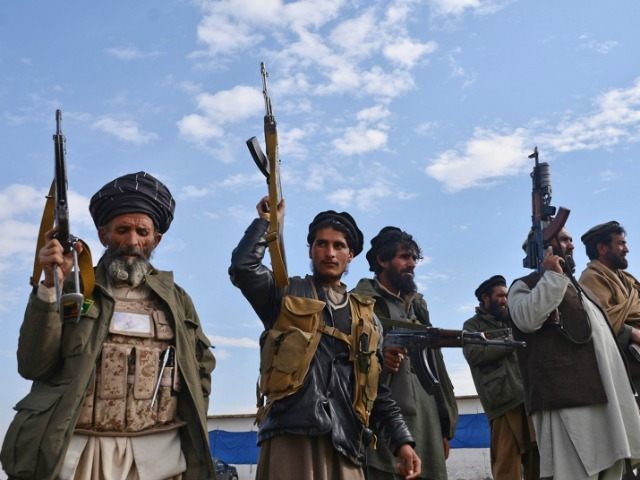The government of Afghanistan is reportedly appealing to militia groups and veterans of the resistance against Soviet invasion in the 1980s to fight the Taliban as it rampages across northern Afghanistan and U.S. troops continue their withdrawal.
Turkey’s Andalou Agency on Thursday quoted human rights activists who expressed concerns about the training, arms, and discipline of these militias, which Afghanistan’s new defense and interior ministers have taken to calling “popular uprising forces.” Skeptics feared there would be little vetting of militia groups and not much supervision of their activities:
Nezam Uddin, the chairman of the Peace and Human Rights Organization, feared that without a robust regulatory mechanism, the distribution of arms and extension of impunity would plunge the country further into a deeper crisis. “The drive of forming and arming local militias in remote areas away from regulatory mechanism and oversight means anyone can exploit the situation for personal or factional gains in a lethal way,” he told Anadolu Agency.
The idea of forming a militia had previously also caused concerns among the rights group, with the Human Rights Watch calling for completely scarping the idea. It warned in a report that such militias with reduced training and potentially less oversight risk being yet another abusive power group operating outside the military’s chain of command.
“The Afghan government’s expansion of irregular forces could have enormously dangerous consequences for civilians,” said Patricia Gossman, a senior researcher at Human Rights Watch.
Gossman suggested the Afghan government should instead seek U.S. and NATO assistance to “strengthen training and oversight to ensure that all forces respect the law.” As dismayed residents of northern Afghanistan are pointing out, the U.S. and NATO spent twenty years “strengthening” the regular Afghan military, but it keeps retreating and surrendering in the face of Taliban assaults.
The Taliban now commands over half the districts in Afghanistan, although only about one-third of the population lives under its control. Analysts believe eight entire provinces could fall to the Taliban before U.S. withdrawal has even been completed. Several cities, ports, and border crossings were reportedly taken without a shot being fired when Afghan troops abandoned their posts.
Government officials are increasingly interested in supporting citizens who wish to resist the Taliban invasion, often with the help of the mujahideen – veterans of the guerrilla war against the Soviets four decades ago, and their disciples. A district governor in Kandahar province told Andalou that militia forces will be well-armed, paid government salaries, and trained to “fight alongside the Afghan police and the Afghan National Army against the Taliban.”
The militia movement was gaining steam before local governors or national security officials in Kabul began endorsing it. One of the largest and best-organized anti-Taliban militias took up arms in April, its ranks largely filled with Hazaras, a Persian-speaking Shiite Muslim ethnic minority from central Afghanistan whose men, women, and children have been wantonly murdered by Taliban and Islamic State forces.
Hazara leaders say they were ready to fight because they never had much faith in the ability, or desire, of the Kabul government to protect them. They have also expressed anger at departing U.S. and NATO forces for not defending them against attacks they fear will escalate into genocide.
“The world doesn’t speak about our deaths. The world is silent. Are we not human?” a grieving Hazara said at the funeral for victims of an early June bomb attack.
“The U.S. can go into space, but they can’t find out who is doing this? They can see an ant move from space, but they can’t see who is killing Hazaras?” said another.
The ethnic, religious, and ideological composition of these militia groups is one of the characteristics that worry observers. Skeptics say many militia leaders are little better than warlords, armed ethnic groups have scores to settle with each other as well as the Taliban, and the outcome could replace the Taliban offensive with all-out civil war. The most troubled of these skeptics note that many of the factions standing up citizen armies to fight the Taliban are not fond of the politically dominant Pashtun group, which includes President Ashraf Ghani.
Ghani, who will be in Washington on Friday to discuss security issues, made a public appeal Monday for militia leaders to form a “united front” with government police and military forces to “safeguard the republic system.”
Ghani’s newly appointed Defense Minister Bismillah Khan Mohammadi even more bluntly called on “patriots and people everywhere to stand alongside their security and defense forces,” promising “equipment and resources” from Kabul to those who answer the call.
The Taliban responded to the growing militia movement by unconvincingly promising to “accommodate all rights of citizens in our country,” and much more earnestly vowing to kill anyone who dares to fight against them.
“Those individuals who are still fanning the flames of war and conflict in the country, arming [militias] in the name of defense or exploiting common people in the name of uprisings to maintain their illegitimate hold on power, should know that the attitude of the Islamic Emirate towards them will be stern and they will be deprived of amnesty,” the Taliban said in a statement on Wednesday, adding a thinly veiled threat to attack the families and children of “war-mongering” militia members.

COMMENTS
Please let us know if you're having issues with commenting.